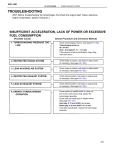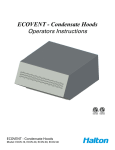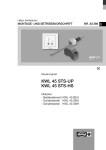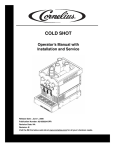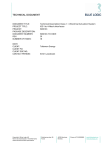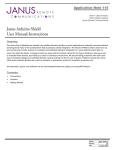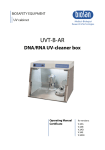Download EcoVentTM Recirculator Installation Manual SM-337
Transcript
NELSON Nelson EcoVent Recirculator NELSON ® ® EcoVent Recirculator Installation Manual SM-337 TM ©Fleetguard All Rights Reserved Printed in U.S.A. LT35014 2/03 Q55916 NELSON Nelson EcoVent Recirculator NELSON ® Nelson EcoVent Recirculator ® Maintenance Instructions Whenever the manometer shows a reading of 1.5" H2O positive pressure, you must replace the EcoVent filter element. 1. With the engine shut off and cooled, remove the EcoVent’s cover clamp, cover and cover gasket. 2. Remove the hex nut, element seal plate and element. 3. Replace the element with the proper new element. Inspect the cover gasket and grommet on the element seal plate and replace if cut, damaged or swollen. 4. Replace the parts in the same order in which you removed them. 5. Start the engine and check the manometer. If it is not showing a 0" to 0.3" H2O positive pressure reading, follow the adjustment instructions on pages 9 and 10 to adjust the air flow. Hex Nut Step 1 Cover Clamp Element Seal Plate Cover Gasket Element Cover Grommet Step 2 Figure 9 • Parts to be removed during maintenance. Parts List Description EcoVent Filter Element Cover Gasket Grommet Nut 2 93196A Part Number 93195A 93194A 93192A 88468A Q58510 Q58521 Q53714 88467A Q58510 Q58521 Q53714 88465A Q58403 Q58521 Q01428 88365A Q58403 Q58521 Q01428 NELSON NELSON Nelson EcoVent Recirculator About This Product Use 3/8" I.D. clear flexible tubing and clamp. Nelson’s EcoVent Recirculator removes 99.9% of oil mist and airborne particles coming from the engine crankcase breather vent. Because the separation of crankcase fumes and oil is accomplished by means of a static absorbent filter, there are no moving parts. There is also no need for periodic cleaning—you only have to change the filter element! Open to atmosphere. To Ecovent manometer gauge connection. Fill the U-tube gauge with the red gauge oil supplied. Install the gauge in a vertical plumb position. Adjust the U-tube to zero with both connections vented to atmosphere. 8 7 6 5 4 3 2 1 0 1 2 3 4 5 6 7 8 Gauge reads in inches of water. Gauge reading with new element must not exceed 0 to 0.3 inches of water at normal engine operating speed. Figure 7 • U-tube Manometer Gauge Reading With New Filter Element Nelson EcoVent Recirculator ® ® To properly read the U-tube gauge, you must add the readings on both sides of the U-tube gauge. Example: the gauge at the right shows a gauge reading of 1.5 inches of water. 0.75 + 0.75 =1.5 8 7 6 5 4 3 2 1 0 1 2 3 4 5 6 7 8 The EcoVent filter element must be changed when the gauge reading reaches a maximum of 1.5 inches of water. The EcoVent Recirculator makes it possible to duct clean blowby fumes into the air cleaner, for a completely closed system, thereby removing 100% of the blowby mists and gases from the atmosphere without danger to the engine. This provides for a cleaner, healthier and safer environment while reducing engine room maintenance costs. Figure 8 • U-tube Manometer Gauge Reading At Filter Element Changeout Operating Instructions Once you have installed and adjusted the EcoVent, operating instructions are very simple: • Monitor the reading on the manometer. When it reaches a reading of 1.5" H2O positive pressure (see figure 8) replace the EcoVent element, as shown in the Maintenance Section. • If you are not returning the oil to the engine, drain the oil from the EcoVent as needed. Figure 1 • The EcoVent Recirculator attached to an engine. ! WARNING Read the entire Service Manual before attempting the installation! NELSON NELSON Nelson EcoVent Recirculator ® Nelson EcoVent Recirculator ® Installation Manometer Gauge Connection You can install the EcoVent Recircualtor in one of two ways: with the outlet connected to the engine’s air inlet flow before the air filter (Option 1) or directly to the engine’s air intake ducting (Option 2). Please follow the instructions for your specific situation. Engine Crankcase Breather Vent to EcoVent Inlet Connection Engine Air Intake Filter Control Valve Option 1: Connecting the Outlet to the Air Inlet Flow See Figures 2 or 3 for an illustration of a correctly installed EcoVent Recirculator. ☞ NOTE Drain Valve In all cases, you can substitute a rigid pipe where the instructions call for a heat-resistant hose. AIN DR IL O 1. Use the two mounting brackets we have provided to mount the EcoVent on or adjacent to the engine. You must mount the EcoVent horizontally and above the engine crankcase oil level. 2. Follow the manufacturer’s instructions to attach the U-tube manometer gauge (which we have supplied) to the manometer gauge connection on the EcoVent. 3. Attach the proper size of heat-resistant hose to the EcoVent’s inlet connection and secure with a hose clamp. 4. Attach the end of the hose used in Step 3 to the engine’s crankcase breather vent tube and secure with a hose clamp. EcoVent Outlet Connected Directly to Air Intake Ducting Figure 5 • Completed installation, showing oil being drained. Adjusting the Air Flow If, at normal engine operating speed the U-tube manometer gauge does not show a 0" to 0.3" H2O positive pressure reading, perform the proper adjustment to correct it. 1. If the EcoVent’s outlet hose is connected near the air inlet flow, move the open end of the hose into or out of the flow until the manometer shows the proper reading, then secure it with a hose clamp. 5. Attach another length of heat-resistant hose to the EcoVent’s outlet connection and secure with a hose clamp. 6. Attach the end of the hose used in Step 5 to the engine’s air intake filter near the air inlet flow and secure with a hose clamp. ! CAUTION If you connect the EcoVent’s outlet hose to the air inlet flow before the air intake filter, position the end of the hose so that the vacuum created by the air flow produces a 0" to 0.3" H2O positive pressure reading on the U-tube manometer. See figure 7. At normal engine operating speed a new EcoVent unit must not have more than 0.3" H2O positive pressure! Air Flow Air Cleaner Hood Hose to EcoVent Outlet Figure 6 • Move the outlet hose into or out of the air flow to adjust the pressure. 2. If the EcoVent’s outlet hose is connected directly to the air intake ducting, adjust the control valve on the outlet hose until the manometer shows the proper reading. Once the initial proper gauge reading has been established, do not adjust the location of the hose or the control valve during the life of the EcoVent element. NELSON NELSON Nelson EcoVent Recirculator Manometer Gauge Connection Engine Crankcase Breather Vent to EcoVent Inlet Connection Engine Air Intake Filter Control Valve If You Are Returning the Oil to the Engine If the engine does not use natural gas or fuels that contain sulfur or halogen chemicals, you can return the oil collected directly to the engine oil sump. ! EcoVent Outlet Connected Directly to Air Intake Ducting Drain Line Must be Below Oil Level Figure 4 • Completed installation, showing the oil being returned to the engine. Nelson EcoVent Recirculator ® ® CAUTION If the engine uses natural gas or fuels that contain sulfur or halogen chemicals, do not return the collected oil to the engine. If this applies to your installation, please turn to the next section for more information. 7. Connect a drain tube to the drain port on the underside of the EcoVent. 8. Place the other end of the drain tube into the engine oil sump, below the oil level line. Manometer Gauge Connection Engine Crankcase Breather Vent to EcoVent Inlet Connection Engine Air Intake Filter If the Engine Uses Natural Gas or Fuels Containing Sulfur or Halogen Chemicals 7. Connect a drain tube to the drain port on the underside of the EcoVent. 8. Connect a drain valve to the drain tube. 9. Place an oil reservoir at the end of the drain tube. How often you drain the EcoVent depends upon the amount of oil in the engine crankcase fumes and the condition of the engine. 10. Check the adjustment of the EcoVent by starting the engine and running it at normal operating speed. The U-tube manometer gauge should have a 0" to 0.3" H2O positive pressure reading. If not, adjust the air flow until it does. See the Section entitled Adjusting the Air Flow for more information. EcoVent Outlet Connected to Engine Air Inlet Flow Drain Line Must Be Below Oil Level Figure 2 • Completed installation, showing the oil being returned to the engine. 9. Check the adjustment of the EcoVent by starting the engine and running it at normal operating speed. The U-tube manometer gauge should have a 0" to 0.3" H2O positive pressure reading. See figure 7. If not, adjust the air flow until it does. See the Section entitled Adjusting the Air Flow for more information. If the Engine Uses Natural Gas or Fuels Containing Sulfur or Halogen Chemicals 7. Connect a drain tube to the drain port on the underside of the EcoVent. 8. Connect a drain valve to the drain tube. NELSON NELSON Nelson EcoVent Recirculator 9. Place an oil reservoir at the end of the drain tube. How often you drain the EcoVent depends upon the amount of oil in the engine crankcase fumes and the condition of the engine. Manometer Gauge Connection ® ® Engine Crankcase Breather Vent to EcoVent Inlet Connection Engine Air Intake Filter Nelson EcoVent Recirculator 3. Attach the proper size of heat-resistant hose to the EcoVent’s inlet connection and secure with a hose clamp. 4. Attach the end of the hose used in Step 3 to the engine’s crankcase breather vent tube and secure with a hose clamp. 5. Attach another length of heat-resistant hose to the EcoVent’s outlet connection and secure with a hose clamp. Drain Valve EcoVent Outlet Connected to Engine Air Inlet Flow AIN DR IL O 6. Install a control valve on the hose used in Step 5, then attach the end of the hose directly to the engine’s air intake ducting and secure with a hose clamp. You can attach the hose either before or after the engine’s air filter. The control valve is used to regulate the maximum 0" to 0.3" H2O positive pressure reading for the new EcoVent element. See figure 7. Do not adjust this valve after you have properly set it to achieve the 0" to 0.3" H2O positive pressure reading. ! Figure 3 • Completed installation, showing oil being drained to an oil reservoir. 10. Check the adjustment of the EcoVent by starting the engine and running it at normal operating speed. The U-tube manometer gauge should have a 0" to 0.3" H2O positive pressure reading. If not, adjust the air flow until it does. See the Section entitled Adjusting the Air Flow for more information. Option 2: Connecting the Outlet Directly to the Air Intake Ducting See Figures 4 or 5 for an illustration of a correctly installed EcoVent Recirculator. ☞ NOTE In all cases, you can substitute a rigid pipe where the instructions call for a heat-resistant hose. 1. Use the two mounting brackets we have provided to mount the EcoVent on or adjacent to the engine. You must mount the EcoVent horizontally and above the engine crankcase oil level. 2. Follow the manufacturer’s instructions to attach the U-tube manometer gauge (which we have supplied) to the manometer gauge connection on the EcoVent. CAUTION With the EcoVent’s outlet hose connected, along with the control valve, directly to the engine air intake ducting, simply adjust the control valve so that the vacuum created by the air flow is 0" to 0.3" H2O positive pressure reading on the U-tube manometer guage. See figure 7. At normal operating speed a new EcoVent unit must not have more than 0.3" H2O positive pressure! If You Are Returning the Oil to the Engine If the engine does not use natural gas or fuels that contain sulfur or halogen chemicals, you can return the oil collected directly to the engine oil sump. ! CAUTION If the engine uses natural gas or fuels that contain sulfur or halogen chemicals, do not return the collected oil to the engine. Please turn to the next section for information on completing the installation if this applies to your installation. 7. Connect a drain tube to the drain port on the underside of the EcoVent. 8. Locate the other end of the drain tube into the engine oil sump, below the oil level line. 9. Check the adjustment of the EcoVent by starting the engine and running it at normal operating speed. The U-tube manometer gauge should have a 0" to 0.3" H2O positive pressure reading. If not, adjust the air flow until it does. See the Section entitled Adjusting the Air Flow for more information.






